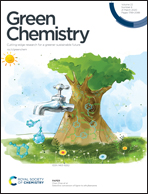Superhydrophobic nickel/carbon core–shell nanocomposites for the hydrogen transfer reactions of nitrobenzene and N-heterocycles†
Abstract
In this work, catalytic hydrogen transfer as an effective, green, convenient and economical strategy is for the first time used to synthesize anilines and N-heterocyclic aromatic compounds from nitrobenzene and N-heterocycles in one step. Nevertheless, how to effectively reduce the possible effects of water on the catalyst by removal of the by-product water, and to further introduce water as the solvent based on green chemistry are still challenges. Since the structures and properties of carbon nanocomposites are easily modified by controllable construction, a one step pyrolysis process is used for controllable construction of micro/nano hierarchical carbon nanocomposites with core–shell structures and magnetic separation performance. Using various characterization methods and model reactions the relationship between the structure of Ni@NCFs (nickel–nitrogen-doped carbon frameworks) and catalytic performance was investigated, and the results show that there is a positive correlation between the catalytic performance and hydrophobicity of catalysts. Besides, the possible catalytically active sites, which are formed by the interaction of pyridinic N and graphitic N in the structure of nitrogen-doped graphene with the surfaces of Ni nanoparticles, should be pivotal to achieving the relatively high catalytic performance of materials. Due to its unique structure, the obtained Ni@NCF-700 catalyst with superhydrophobicity shows extraordinary performances toward the hydrogen transfer reaction of nitrobenzene and N-heterocycles in the aqueous state; meanwhile, it was also found that Ni@NCF-700 still retained its excellent catalytic activity and structural integrity after three cycles. Compared with traditional catalytic systems, our catalytic systems offer a highly effective, green and economical alternative for nitrobenzene and N-heterocycle transformation, and may open up a new avenue for simple construction of structure and activity defined carbon nanocomposite heterogeneous catalysts with superhydrophobicity.



 Please wait while we load your content...
Please wait while we load your content...